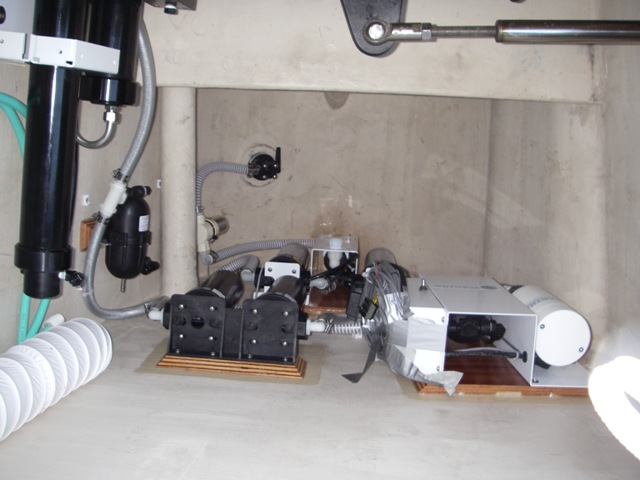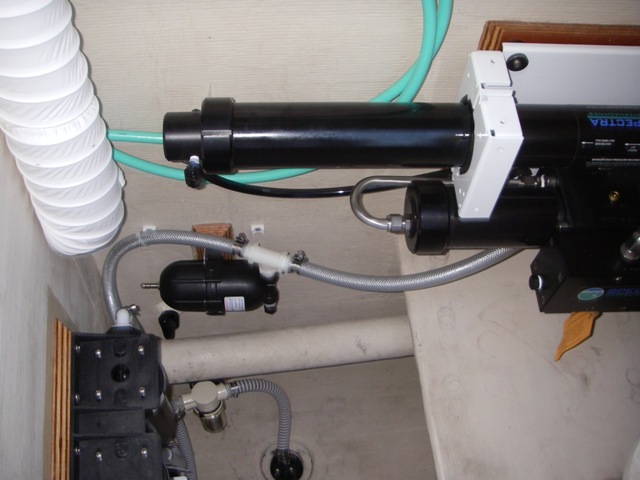

It is the end of May. I have been officially unemployed for 4 days, although in reality I have been playing on the dock for 2 weeks. I have started to get the boat in order (aka installing lots of stuff!) and it is more work than it looks. To give you an idea of the effort involved in relatively simple tasks let me tell you about installation of the water maker.
The water maker consists of a hole in the boat (salt water has to get in, after all). A hose comes from the hole in the boat and into a strainer (we don't want seaweed and other crap in the system - hence the strainer). The hose then passes through a fine filter and into a feed pump. From the feed pump, it goes through another set of filters, and into a high pressure pump and through a reverse osmosis membrane and back out the boat through another hole. We will ignore the fresh water side for the moment.
So it sounds easy. Mount a few filters, run a few hoses and your done! Well, there are a few complications. Number one, I don't want to drill mounting screws into the hull as I believe the fewer holes in your hull the better. So I decided to glue plywood to the side of the boat, then screw my mounting screws into that. Plywood is not just plywood. They have "marine" plywood (made from Mahogany and other supposedly water resistant stuff) and "regular" plywood just isn't good enough. It rots and falls apart. So off I went to Home Depot to get some Marine Plywood. You are all probably ahead of me already - sure enough Home Depot didn't have any, nor did they know where to get it. So I went home and hit the internet. After some google searches I found a source right in Somerville of all places!
The guy there said that yes it is "Marine" plywood, but you still need to seal it from the water with some sort of sealant. That means that after you have laid out your water maker components and decided how many pieces of wood you need and what size they should be, you have to mix up a batch of epoxy and coat every piece of wood with epoxy. If you have never worked with epoxy, that is an adventure itself which I won't go into - save to note that balancing a pot of glue on the top of a hatch on a windy day is definitely NOT a good idea - even if it is only for a minute.
So after 2 full days of effort, I now have a giant sheet of plywood, a circular saw and some resin to make the epoxy. Next comes measuring, cutting and sealing with epoxy. I cut out the plywood into patterns that fit the attachment spots on the pump, membrane etc, then lay them on plastic and cover them with resin mixed with hardener (epoxy). I now have to wait 24 hours for it to harden. At this point, it is day 3, and all I have is a couple of pieces of wood and a wife who asks how is the progress coming?
Day 4, now I have to glue the wood to the hull and bulkheads in the boat. Again, this is more involved than the prior sentence would suggest. In order to glue the wood bits to the hull, I need to know where the components will go. This means I have to lift them in place and see if they fit in the chamber to which they have been consigned. Seeing as the membrane weighs 40 pounds or so, and is a bit trying (to say the least) to try and hold the membrane in place while holding the bit of wood into which it will be screwed, while drawing an outline with a pencil and holding myself sideways in the lazarette. I was sweating, cursing and bloody by the time it was done - and all I had to show for it was 7 outlines in pencil on the walls of the lazarette.
Now some genius comes around (who shall remain nameless to protect the innocent) and asks me if I plan to glue those things to paint, because paint "comes off" sometimes. So now, of course, I decide to sand down below to the fiber glass beneath the paint to get a good bearing surface. After 2 hours of sanding (no I didn't have an electric sander) I was still not down "through the paint". At this point, I decided the paint was pretty tough stuff - if I can't get through it in 2 hours it must be able to hold a 40 pound weight in 12 foot seas.
So, I endeavor to mix a big batch of epoxy and glue the plywood into place. If you have ever tried to hold a glue covered piece of plywood exactly in place with one hand (if it moves the equipment won't fit properly), while balancing on your side with the other hand, holding a roll of duct tape with the other hand while tearing/cutting it with the other hand, you don't quite realize that this is harder than it sounds. Anyway, at the end of 5 days I have 7 pieces of plywood glued to the wall. Need I say more?
The best part is, after all that, they are only "glued to the paint."
Doesn't look like much does it ....

